Looking For The gynecomastia surgery in Navi Mumbai?
Gynecomastia is a condition that makes breast tissue swell in men. It can happen when the balance of two hormones in your body is thrown off. PVR Aesthetica offers the best gynecomastia surgery in Navi Mumbai.
- No Recurrence
- Quick Recovery
- No Visible Scars
Book An Appointment Now!
Ratings
Trusted By Patients All Over India






Before & After
Gynecomastia
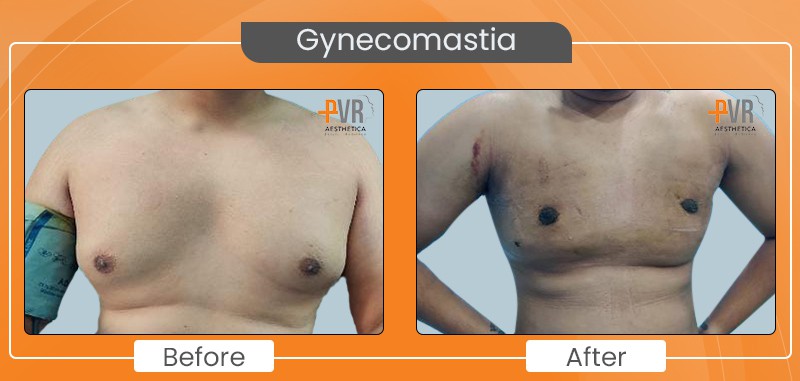
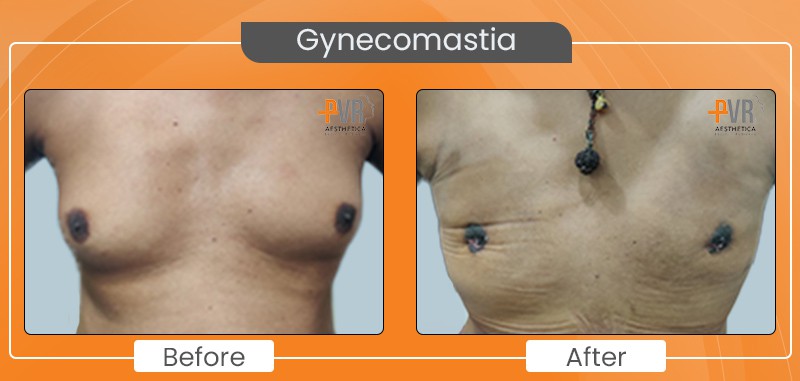
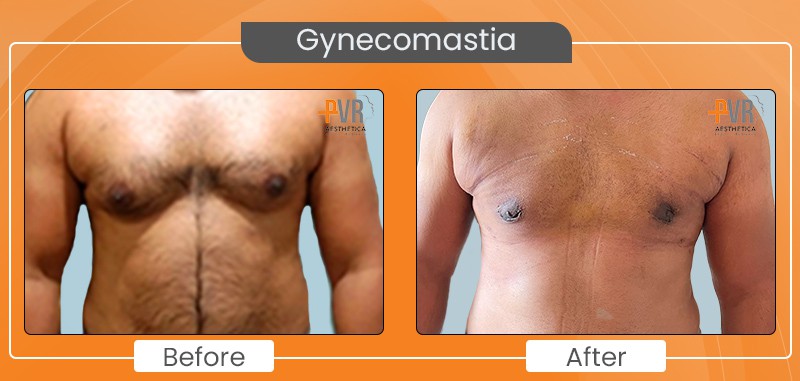
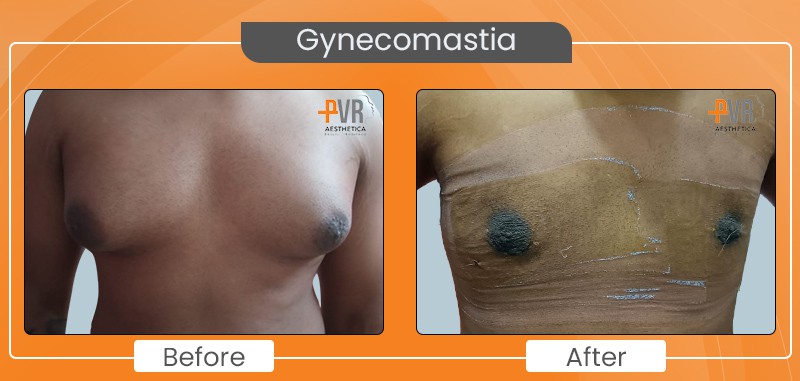
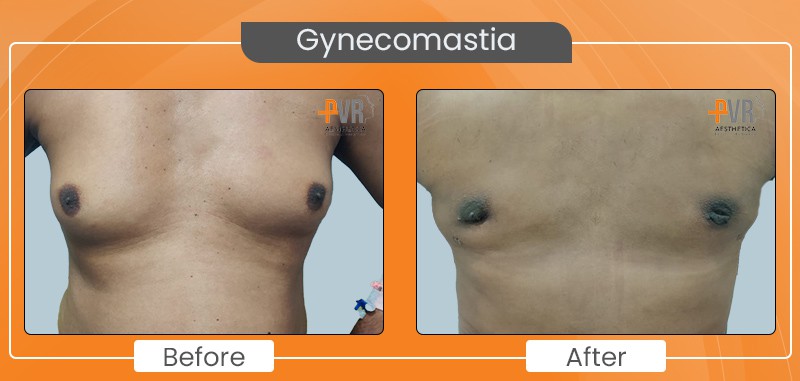
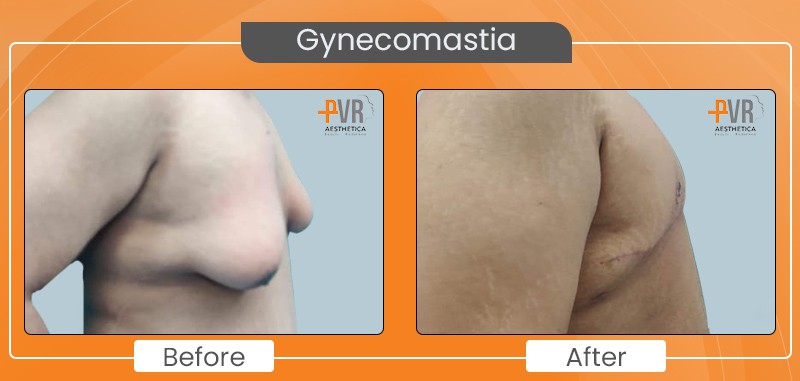
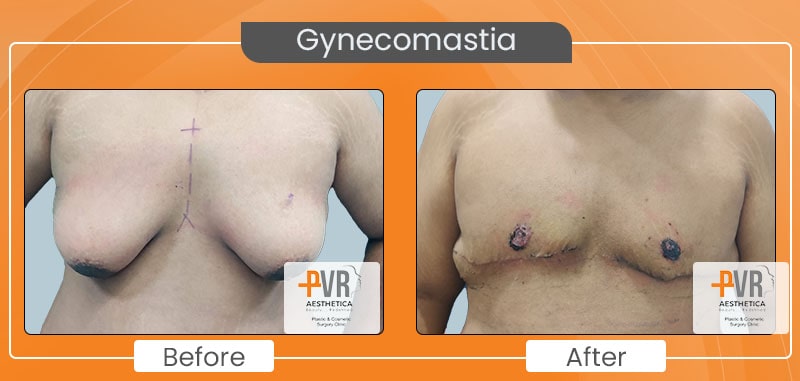
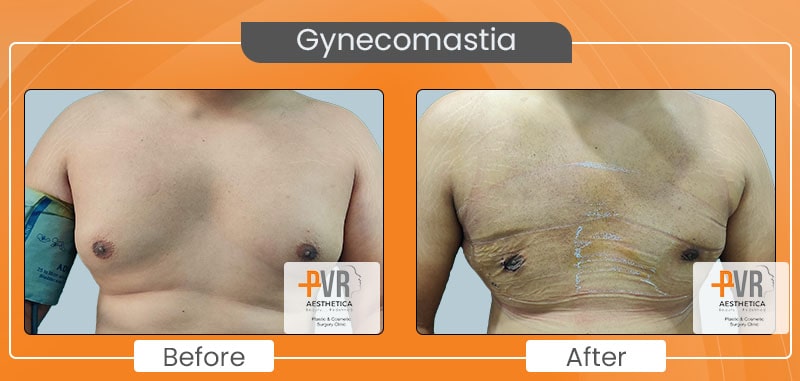
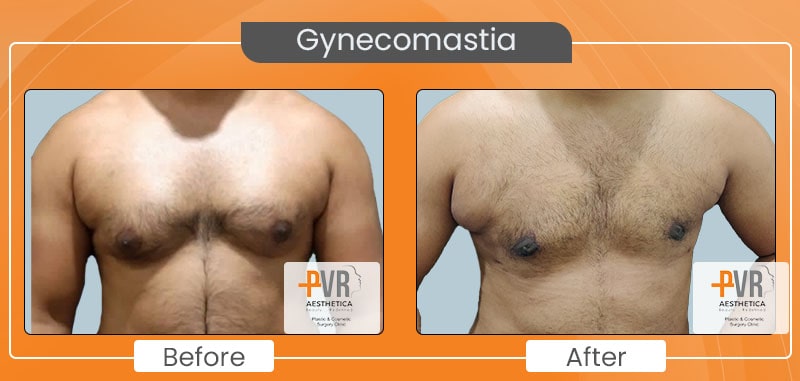
Facilities
At PVR Aesthetica we offer

Medical Expertise
Internationally acclaimed in medical care using modern technologies.

Excellent Service
Providing High-quality medical care and service at an affordable price.

Clinical Perfection
Our team works tirelessly to provide care and treatment of the highest standard.

Post-treatment Care
Quick recovery with adherence to post-procedure processes and follow-up consultations.
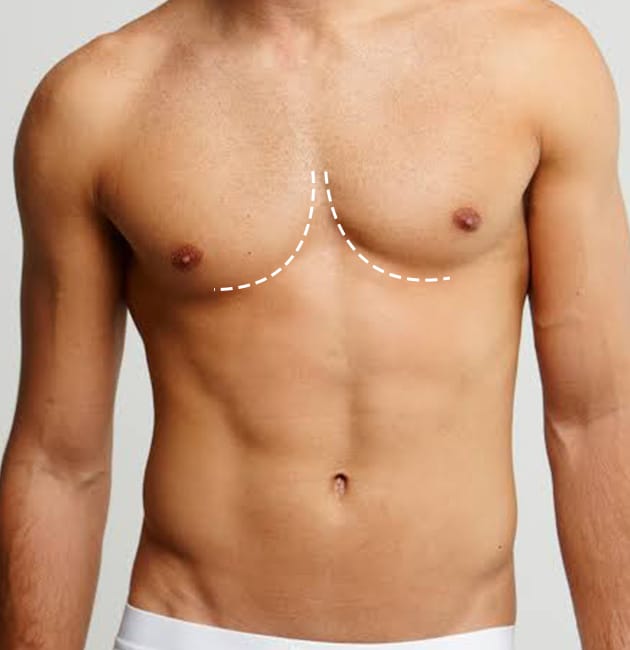
Why Us?
Why PVR Aesthetica?
PVR Aesthetica offers the most technically advanced medical care and cosmetic solutions. If you wish to seek gynecomastia by India’s most reputed cosmetic surgeon, walk into PVR Aesthetica for trusted body care.
Our Team
Meet Our Doctor
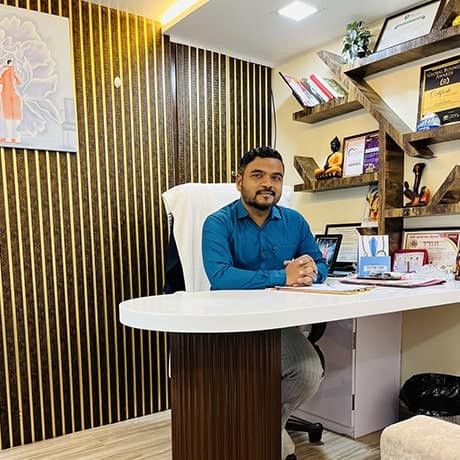
DR. VINOD PACHADE
( MBBS, MS, M.CH, DNB, FACS, MNAMS )
Dr. Vinod Pachade is the founder and director of the PVR Aesthetica Cosmetic Surgery Center. He is the member of Association of Plastic Surgeons of India (APSI) and also the winner of Asia Book of Records.
He is a renowned plastic/cosmetic surgeon in Navi Mumbai. He specialises in :
- hair transplant
- Gynecomastia
- Breast surgery
Ready To Lose Male Chest Fat?
Consult Now!
FAQ's
Frequently Asked Questions
In case of severe gynecomastia, the patient's chest area may look like a woman's breast. But when it comes to the most common cases, there will just be a bump under the nipple, which usually starts during puberty. In the less severe gynecomastia, the bump goes away over time. But sometimes, it may not go away, which means there will be a need for surgery. In addition, when it gets bigger, the bump can make your nipples look big, causing them to stick over the clothes.
Moreover, if a kid is overweight, this bump will become even more prominent and look like a woman's chest. That's why this medical condition is also known as male boobs. Although some kids try to ignore it, hoping it will go away on its own, this experience can be quite jarring for someone in their school or college days. That's why most parents try to push them to visit the doctor for surgery.
If you are looking for gynecomastia surgery in Navi Mumbai, come over to PVR Aesthetica. We are one of the best clinics in the Mumbai metropolitan area, providing treatment for gynecomastia in Navi Mumbai.
There have been several studies researching the frequency of gynecomastia among the general population. The frequency of gynecomastia is around 60% to 70% among the masses, which is quite high. These studies have found gynecomastia to be most common in males of three age groups: newborns, boys in the age of puberty and older men (in senior ages).
The primary cause of gynecomastia is hormonal imbalance. In men, testosterone (male sex hormone) is higher than oestrogen (female sex hormone). But when the oestrogen levels become abnormally higher than testosterone, it stimulates the breast tissue growth under and around the nipples.
The testosterone not bound to the protein present in the blood is called free serum testosterone. The experts have found this type of testosterone to be lower in young boys suffering from gynecomastia.
Gynecomastia can be quite common in young boys with a deficiency of free serum testosterone. So if you are looking for gynecomastia surgery in Navi Mumbai, come over to PVR Aesthetica. Not only do we have excellent facilities and infrastructure, but our gynecomastia surgery cost in Navi Mumbai is also affordable enough for anyone to avail of the procedure.
In some cases, a gynecomastia bump can indicate the presence of issues like hormonal tumours in adrenal glands, testicles or even more commonly, the brain. So in these cases, removing the gynecomastia lump through surgery will not be enough as it will not treat the root cause. For example, not too long ago, a patient had cancer in his adrenal glands due to which there was overproduction of oestrogen, resulting in the male patient having C-cup sized breasts. He had the treatment, but the gynecomastia condition worsened, which is why he required further cancer treatments.
That's why the doctors consider several possibilities in the case of gynecomastia patients, as there can be life-threatening issues associated with them. So a testicle exam or ultrasound will be efficient in clearing any doubts the doctors may have.
If you are experiencing gynecomastia symptoms, come over to PVR Aesthetica, one of the best clinics for male breast reduction in Navi Mumbai. Our experts consider every possibility during the consultation and diagnosis to ensure the patient gets the most effective treatment.
Although there wouldn't be extra stimulation, your breast tissue won't return to normal. As time goes by, additional drug cycles may result in a tissue build-up with an accumulation of fat, glandular and scar tissue. In severe cases, your chest may look like female breasts with nipples pointing forwards.
Unfortunately, there is no way to predict if you are going to have gynecomastia. This medical condition is often caused as a side effect of certain medications. So there is no way for a doctor to predict if a person will have side effects from a drug, resulting in male breasts or gynecomastia.
One of the most frequent questions concerning gynecomastia raised by patients worldwide is "Can gynecomastia be caused due to medications other than steroids?". Simply put, yes. Several patients tend to admit to marijuana usage before telling the doctor about the steroids. There are several medications like those for high blood pressure and ulcers that may cause gynecomastia. Another factor people tend to ignore is alcohol. It can affect the liver's metabolism, enhancing the effects of medications and resulting in gynecomastia.
If you are experiencing male breast development due to side effects of medications, come over to PVR Aesthetica for gynecomastia surgery in Navi Mumbai.
The tissue under the nipple may be stimulated again due to the same factors, resulting in gynecomastia.
Now, you may think that a person undergoing the gynecomastia procedure will be more worried about the recurrence of the issue. But since most of the patients are bodybuilding and fitness enthusiasts, the thing they are most concerned about is when they can get back to their daily routine, especially the gym workout.
Since this condition is more frequent in bodybuilding enthusiasts, there may be a risk of bleeding within at least a week of the surgery. Therefore, after the procedure, they will need to limit their physical activity to light exercises for at least one week, after which they can resume their daily routine.
Usually, insurance is of no help when it comes to gynecomastia surgery. Since gynecomastia surgery is considered a cosmetic procedure, most insurance providers don't consider it valid for an insurance policy claim. But you can consider visiting your insurance provider to get a better idea of whether your policy covers gynecomastia surgery or not.
Are you looking for surgery to treat gynecomastia in Navi Mumbai? Then, come over to PVR Aesthetica, as we have state-of-the-art facilities and advanced technologies, along with affordable gynecomastia surgery costs in Navi Mumbai. So book your appointment for a consultation today!
Reviews
Patient Testimonials
What Is Gynecomastia?
Gynecomastia is a condition characterized by the enlargement of breast tissue in men. It is a common condition that can affect men of all ages, from teenagers to older adults.
It occurs when the breast tissue in males enlarges, resulting in a more prominent and sometimes feminine appearance of the chest. It is crucial to differentiate gynecomastia from having excess fat in the chest area, which can lead to a similar appearance but is distinct from the enlargement of breast tissue.
Gynecomastia treatment does not help with weight loss. It is a surgical intervention aimed at reducing the amount of breast tissue for a more masculine and natural chest contour.
Sometimes, the weight of the extra tissue causes breast sagging that stretches the areola (the dark skin around the nipples).
What Is Simon’s Classification Of Gynecomastia?
Simon et al have classified Gynecomastia into 4 grades based on its severity so that appropriate treatment can be designed for each class.
Level of Gynecomastia severity
| Grade | Description |
| I | Mild enlargement with no excess skin |
| IIa | Moderate enlargement with no excess skin |
| IIb | Moderate enlargement with excess skin |
| III | Marked enlargement with excess skin |
Here is a short video on Gynecomastia explained by Dr Vinod Pachade, founder of PVR Aesthetica.
What Is Puffy Nipple?
A puffy nipple is a type of nipple, especially in men, that appears swollen, protruded, or more prominent than usual. It is a common symptom and physical manifestation of gynecomastia, a condition characterized by the enlargement of breast tissue in males.
Puffy nipples further contribute to the appearance of feminine-like breasts with their raised or mound-shaped appearance on the chest.
Is Puffy Nipple Connected To Gynecomastia?
Gynecomastia is primarily caused by hormonal imbalances, leading to an increase in breast tissue and, consequently, an altered chest contour. In some cases, this hormonal imbalance can result in localized swelling and enlargement of the nipple-areolar complex, causing the nipple to take on a puffy or protruding appearance.
A puffy nipple condition is a visible symptom of gynecomastia. Low testosterone and anabolic steroids may also result in puffy nipples.
Many individuals with gynecomastia may experience this concern, and it can exacerbate feelings of self-consciousness and dissatisfaction with one’s body.
What Are The Treatment Options For Puffy Nipples?
There are treatment options for puffy nipples to create a more masculine and contoured chest.
Gynecomastia Surgery: For individuals with gynecomastia and puffy nipples, male breast reduction surgery is often recommended. The procedure involves removing excess breast tissue, sculpting the chest for a more natural contour, and addressing the appearance of puffy nipples.
Liposuction: In cases where excess fat contributes to the appearance of puffy nipples, liposuction may be employed to remove stubborn fat deposits and restore a smoother, flatter chest.
Areola Reduction: In some instances, a puffy nipple may be due to enlarged areolas. Areola reduction creates a more proportional and aesthetically pleasing nipple-areolar complex.
If you are troubled by the appearance of puffy nipples or suspect that you may have gynecomastia, book a consultation at PVR Aesthetica. Our experts will provide the support that you seek.
The Causes Of Gynecomastia
Gynecomastia can be caused by a variety of factors. In this informative guide, we will delve into the diverse causes of gynecomastia to shed light on this often-misunderstood condition.
Hormonal Imbalances: Hormonal imbalances, particularly an imbalance between estrogen (the female hormone) and testosterone (the male hormone), are one of the primary causes of gynecomastia. Under normal circumstances, men have higher levels of testosterone, which helps to keep the effects of estrogen in check.
However, when estrogen levels increase or testosterone levels decrease, the delicate hormonal balance can be disrupted, leading to the development of breast tissue.
Certain Medications: Gynecomastia can be a side effect of various medications. Some drugs, such as anti-androgens, anabolic steroids, anti-depressants, AIDS medications, and certain heart medications, can interfere with hormone production or action, resulting in breast tissue enlargement.
Underlying Medical Conditions: Conditions affecting the testes, adrenal glands, or pituitary gland can disrupt hormone production and lead to gynecomastia.
Additionally, liver or kidney disease, ageing, hypogonadism, tumours, and hyperthyroidism may alter hormone metabolism, potentially contributing to this condition.
Genetics: Genetics can play a role in gynecomastia. If a family member has experienced gynecomastia, there may be a higher likelihood of developing the condition due to inherited traits related to hormone regulation and breast tissue response.
Lifestyle Factors: Lifestyle choices can also influence the likelihood of developing gynecomastia. Obesity, for instance, can lead to increased estrogen production, as fat cells can convert testosterone into estrogen.
Consequently, excess weight can contribute to hormonal imbalances and the development of breast tissue.
Substance Abuse: Substance abuse, including the excessive use of alcohol, marijuana, and other recreational drugs, has been linked to gynecomastia. These substances can disrupt hormone production and lead to breast tissue enlargement.
The Symptoms Of Gynecomastia
It is crucial to recognize the symptoms of gynecomastia for early detection and appropriate treatment. In this comprehensive guide, we will explore the common symptoms of gynecomastia and the diagnostic process involved in confirming this condition.
4 common symptoms of Gynecomastia
- Enlargement of one or both breasts. The breast tissue may feel swollen, rubbery, or firm to the touch. In some cases, the enlargement can be asymmetrical, affecting one breast more than the other.
- Changes in the appearance of the nipples. This can include nipple enlargement, a slight bulge or puffiness around the areola or the nipple pointing in a more downward direction.
- Heightened nipple sensitivity while rubble against clothes.
- Tenderness or sensitivity in the breast area. Some individuals may experience mild to moderate pain or discomfort, especially when touching or applying pressure to the affected area.
Diagnostic Process for Gynecomastia
Physical Examination: The diagnostic process for gynecomastia typically begins with a physical examination by a qualified healthcare professional. During this examination, the healthcare provider will assess the breast tissue for enlargement, texture changes, and any associated tenderness or pain. They may also examine the nipples and areolas for any abnormality.
Medical History Assessment: Obtaining a detailed medical history is essential for identifying potential causes of gynecomastia. The healthcare provider will inquire about any underlying medical conditions, medications currently being taken, past medical history, family history of gynecomastia, and any substance use, including alcohol or recreational drugs.
Hormonal Tests: Since hormonal imbalances are a common cause of gynecomastia, hormonal tests are often conducted to measure the levels of testosterone, estrogen, and other hormones in the blood. These tests help identify any hormonal abnormalities that may contribute to breast tissue enlargement.
Imaging Studies: Imaging studies, such as mammograms or ultrasounds, may be ordered to evaluate the breast tissue further. These tests can help differentiate gynecomastia from other conditions like breast cancer or cysts.
Biopsy: In some cases, if the healthcare provider suspects an underlying medical issue, a biopsy may be recommended. A biopsy involves taking a small sample of breast tissue for examination under a microscope to rule out any cancerous or abnormal growth.
Who Are The Candidates For Gynecomastia Surgery?
Gynecomastia surgery is suitable for individuals with the following characteristics:
- Men with persistent and bothersome breast tissue enlargement.
- Healthy individuals without complicating medical conditions or life-threatening illnesses.
- Men who have realistic expectations and positive outlook on potential outcomes.
- Non-smokers or willing to quit smoking for a designated period.
- Post-pubertal individuals with stable hormone levels.
- Men who are physically active and maintain a stable body weight.
PVR Aesthetica recommends booking a consultation with a qualified plastic surgeon for candidacy assessment.
Treatment Options
Gynecomastia can cause emotional distress and discomfort. Hence, it is essential to remember that there are effective treatment options available.
The type of treatment is based on the underlying medical cause and the level of severity. In this section, we will explore both non-surgical and surgical treatment approaches for gynecomastia.
Non-Surgical Treatment Options
3 non-surgical treatments to look out for:
Lifestyle Changes: For individuals with mild gynecomastia, lifestyle modifications can be the first step towards improvement. Excess fat deposits in the chest area can be reduced with the help of weight reduction and exercise. Incorporating a balanced diet rich in whole foods and low in processed sugars and unhealthy fats can be beneficial.
Medication Adjustment: Gynecomastia can be caused or exacerbated by certain medications, including some antidepressants, anti-anxiety drugs, and anabolic steroids. In such cases, consulting with a healthcare professional to adjust or change medications may lead to a reduction in breast tissue size.
Hormonal Therapy: Hormonal imbalances, such as high estrogen or low testosterone, can trigger gynecomastia. Hormonal therapy may involve the use of medications to restore hormonal balance. SERMs (selective estrogen receptor modulators) are commonly prescribed to manage gynecomastia effectively.
Surgical Treatment Options
There are effective surgical treatment options available in case the non-surgical treatments do not cater to your need.
Liposuction: Liposuction is an effective surgical procedure for treating gynecomastia caused primarily by excess fat tissue. A cannula is used to remove fat deposits from the chest area. Liposuction is less invasive compared to other surgical options and leaves minimal scarring.
Mastectomy: For cases of gynecomastia where breast tissue development is substantial, a mastectomy, also known as the excision technique, may be recommended. This technique is used to remove the glandular tissue for a toned and more masculine chest contour. Depending on the individual’s condition, a surgeon may use either the subcutaneous mastectomy (removing tissue through small incisions) or the open mastectomy technique.
Combination Procedures: In some cases, a combination of liposuction and mastectomy may be necessary to achieve the desired aesthetic outcome. This approach is particularly useful when gynecomastia involves both excess fat and glandular tissue.
Hear from the expert himself. Dr Vinod Pachade from PVR Aesthetica explains the surgical procedure of Gynecomastia treatment.
Preparing for Gynecomastia Surgery
Gynecomastia surgery requires pre-operative preparation to ensure a safe and successful procedure. In this section, we will provide essential information on how one can prepare for gynecomastia surgery, covering pre-operative assessments, medical evaluations, and specific instructions to follow before the procedure.
Consultation with a Plastic Surgeon
During your consultation, a qualified plastic surgeon will conduct a thorough evaluation of your medical history and a physical examination of your chest. This assessment is vital to determine your candidacy for the procedure and to tailor a treatment plan that aligns with your specific needs and expectations.
Understand the Procedure
Take the time to discuss the gynecomastia surgery procedure with your surgeon in detail. Understand the surgical technique that will be used, the expected outcomes, potential risks and complications, and the recovery process.
This knowledge will help manage your expectations and reduce any anxiety you may have about the surgery.
Pre-Operative Medical Evaluation
Before the surgery, your surgeon will likely require a pre-operative medical evaluation. This evaluation may include blood tests, an electrocardiogram (ECG), and a chest X-ray to ensure you are in good overall health and can undergo the surgical procedure safely.
Medication Review
It is essential to inform your surgeon about all medications, supplements, or herbal remedies you are currently taking. Some medications, such as blood thinners or aspirin-containing drugs, may need to be temporarily discontinued to reduce the risk of excessive bleeding.
Smoking and Alcohol
If you are a smoker, your surgeon will strongly advise you to stop smoking well in advance of the surgery. Smoking can interfere with the body’s healing process and increase the risk of complications.
Similarly, alcohol consumption should be limited or avoided in the days leading up to the surgery, as it can also affect healing and recovery.
Fasting Instructions
Your surgeon will provide instructions on fasting before the gynecomastia surgery. Typically, patients are required to avoid eating or drinking anything, including water, for a certain period before the scheduled procedure.
This is essential to prevent potential complications during anaesthesia and surgery.
Types Of Gynecomastia Surgery
There are different surgical techniques available for Gynecomastia treatment. 3 most popular techniques suitable for varying underlying causes and extent of gynecomastia include:
1. Liposuction
It is a commonly used surgical technique for treating gynecomastia cases primarily caused by excess fat deposits in the chest area. It is particularly suitable for individuals with mild to moderate gynecomastia and good skin elasticity.
The procedure involves the following steps:
- Anesthesia: The patient is placed under either local anaesthesia with sedation or general anaesthesia to ensure comfort during the procedure.
- Incision: Small incisions are made around the areola or in inconspicuous locations to allow the insertion of a thin, hollow tube called a cannula.
- Fat Removal: The surgeon uses the cannula to suction out excess fat from the chest, creating a more contoured and masculine appearance.
- Wound Closure: After the fat removal, the incisions are closed with sutures, leaving minimal scarring.
Liposuction alone may not be suitable for individuals with significant glandular tissue enlargement. However, it can be combined with other techniques for more comprehensive results.
2. Excision
The excision technique is appropriate where there is an excessive amount of glandular breast tissue. This method is often recommended for individuals with severe gynecomastia.
The excision technique involves the following steps:
- Anesthesia: The patient is typically placed under general anaesthesia for the procedure.
- Incision: The surgeon makes incisions around the areola or in the natural creases of the chest to access the glandular tissue.
- Glandular Tissue Removal: Excess glandular tissue is carefully excised, resulting in a flatter and more masculine chest contour.
- Nipple Repositioning (if necessary): In some cases, the surgeon may reposition the nipple and areola complex to achieve a natural appearance.
- Wound Closure: After glandular tissue removal, the incisions are closed with sutures to promote proper healing.
3. Combination Technique
In cases where gynecomastia involves both excess fat and glandular tissue, a combination of liposuction and excision may be recommended. The combination technique allows for a more comprehensive approach, addressing both fat and glandular tissue to achieve optimal results.
The surgeon will customize the procedure based on the individual’s unique needs and the extent of gynecomastia.
Suitability and Considerations
The choice of gynecomastia surgery depends on various factors, including the underlying cause of gynecomastia, the extent of enlargement, skin elasticity, and the patient’s aesthetic goals.
Book a consultation at PVR Aesthetica so that the surgeon can assess these factors and recommend the most suitable surgical approach for you.
Gynecomastia Surgery Process / What Is Done In Gynecomastia Surgery?
The Gynecomastia surgery process involves a series of steps aimed at achieving a flatter and more masculine chest contour. While specific details may vary based on the chosen surgical technique and individual patient needs, the overall gynecomastia surgery process typically includes the following key stages:
Preoperative Consultation
Before undergoing gynecomastia surgery, the patient meets with a qualified plastic surgeon for a comprehensive preoperative consultation. During this consultation, the surgeon evaluates the patient’s medical history, performs a physical examination, and discusses the patient’s aesthetic goals and expectations.
The surgeon will also explain the surgical options available and recommend the most suitable technique based on the individual’s unique condition.
Anesthesia Administration
On the day of the surgery, the patient is taken to the operating room, where intravenous sedation or general anaesthesia is administered.
Incision Placement
The surgeon begins the gynecomastia surgery by making incisions in strategic locations. The incision placement is critical and varies depending on the chosen surgical technique and the extent of gynecomastia.
Commonly, incisions are made around the edge of the areola (the dark-pigmented area surrounding the nipple) or in the natural creases of the chest. These incisions are carefully designed to minimize visible scarring after the surgery.
Removal of Excess Breast Tissue or Fat
The next stage of the surgery involves the removal of excess breast tissue, glandular tissue, and/or fat, depending on the specific needs of the patient. If gynecomastia is primarily caused by excess fat, liposuction may be employed to suction out the fat cells through a cannula.
For cases where glandular tissue is the main concern, the surgeon will excise the excess tissue using precision techniques.
Reshaping of the Chest Contour
After the removal of excess tissue or fat, the surgeon focuses on reshaping the chest contour to create a more masculine appearance. This may involve repositioning the nipple and areola complex to ensure they are in harmony with the new chest contour.
Closure of Incisions
Once the desired chest contour is achieved, the surgeon carefully closes the incisions using sutures. The goal is to promote optimal wound healing and minimize scarring. Dissolvable sutures may be used so that the need to remove sutures is eliminated.
Postoperative Recovery
After gynecomastia surgery, the patient is taken to a recovery area where they are closely monitored. Pain medication and post-operative instructions are provided to manage any discomfort and ensure a smooth recovery process.
Recovery And Post-Operative Care
Proper recovery and post-operative care are crucial to ensure optimal healing and achieve the desired results. Here is a general overview of the recovery and post-operative care instructions.
Recovery Period: The recovery period after gynecomastia surgery can vary from person to person, but most individuals can expect initial healing within 1 to 2 weeks. However, it’s essential to remember that complete healing and the final results may take several months to be fully evident.
Pain Management: Pain and discomfort are common in the first few days following gynecomastia surgery. The surgeon will prescribe pain medication to manage any discomfort during this period.
It is essential to take the prescribed medications as directed to stay ahead of any pain and promote a more comfortable recovery.
Wound Care: The incision sites should always be kept clean and dry to minimize the risk of infection and promote optimal healing.
The surgeon will provide specific instructions on how to care for the wounds, including the use of antibiotic ointments or dressings. It’s crucial to follow these instructions diligently to prevent any complications and ensure a smooth recovery.
Compression Garments: Wearing compression garments is a vital aspect of the gynecomastia surgery recovery process. Compression garments help reduce swelling, provide support to the treated areas, and promote better skin retraction.
Patients are typically advised to wear the compression garment continuously for a few weeks after the surgery and may gradually decrease the usage as advised by their surgeon.
Restrictions on Physical Activities: Patients should avoid strenuous physical activities, such as lifting heavy objects, vigorous exercise, and intense sports for a few weeks to allow the body to heal properly.
Follow-Up Appointments: Regular follow-up appointments with the surgeon are crucial during the recovery period. These appointments allow the surgeon to monitor the healing progress, address any concerns, and provide further guidance on post-operative care.
Importance Of Following Post-Operative Instructions
Following post-operative instructions is vital for several reasons:
- Proper wound care, pain management, and activity restrictions promote optimal healing and reduce the risk of complications.
- Following post-operative care guidelines helps minimize the risk of infection, bleeding, and other potential complications.
- Adhering to post-operative instructions can contribute to achieving the best long-term results and a more satisfying outcome.
- Pain management and the use of compression garments enhance patient comfort during the recovery period.
Expected Results And Long-Term Outlook
Gynecomastia surgery aims to create a more masculine and contoured chest, providing both physical and emotional benefits. Let’s explore the expected results and long-term outlook.
Expected Results of Gynecomastia Surgery
5 aesthetically important and life-changing results of Gynecomastia surgery include:
Improved Chest Appearance: The procedure removes excess glandular tissue and fat, resulting in a more natural and masculine chest contour.
Reduction in Breast Size: Gynecomastia surgery effectively reduces the size of the breasts, addressing the enlargement that may cause self-consciousness and discomfort.
Enhanced Self-Confidence: Many individuals experience a significant boost in self-confidence, leading to a more positive body image and improved quality of life.
Symmetry and Proportion: In cases where gynecomastia has caused asymmetry or irregularities in the chest, the surgery can create a more balanced and proportionate chest contour.
Minimal Scarring: Skillfully placed incisions and proper wound care during the recovery process can lead to minimal scarring, allowing individuals to feel more confident about their appearance.
Long-Term Outlook
Gynecomastia surgery provides long-lasting results, and the improvements in chest appearance and self-confidence are typically permanent. However, it is essential to understand that maintaining these results requires ongoing commitment and attention to certain aspects of lifestyle and health:
Healthy Lifestyle: To prevent the recurrence of gynecomastia, maintaining a healthy lifestyle is crucial. This includes adopting a balanced diet rich in whole foods, staying hydrated, and engaging in regular physical activity.
Weight Management: For some individuals, weight fluctuations can contribute to the development or recurrence of gynecomastia. Managing a stable and healthy weight can help prevent future issues.
Medication Management: If gynecomastia was caused or exacerbated by certain medications, it is essential to communicate with healthcare providers about medication usage and potential alternatives.
Avoiding Anabolic Steroids and Illicit Drugs: The use of anabolic steroids and certain illicit drugs can contribute to gynecomastia. Avoiding these substances is crucial for maintaining the results of the surgery.
Gynecomastia Surgery Cost In Navi Mumbai
One crucial aspect that potential candidates consider is the cost associated with the Gynecomastia procedure. The starting cost of gynecomastia surgery in Navi Mumbai is approximately INR 30000 which may increase up to 190000. The fluctuation in the cost of the surgery is based on 8 crucial factors:
Surgical Fees: The surgical fees encompass the charges for the surgeon’s expertise, skill, and experience in performing the gynecomastia surgery. The complexity of the surgery, the surgeon’s reputation, and their level of expertise can influence the surgical fees.
Anesthesia Fees: Gynecomastia surgery is usually performed under either local anaesthesia with sedation or general anaesthesia. The anaesthesia fees will depend on the type of anaesthesia used and the anesthesiologist’s expertise.
General anaesthesia may be relatively more expensive compared to local anaesthesia with sedation.
Facility Charges: Factors that may influence these charges include the location and reputation of the facility, the amenities provided, and the level of care offered. High-quality facilities with advanced medical equipment and a focus on patient safety may have slightly higher charges.
Preoperative and Postoperative Care: The cost of gynecomastia surgery may also include preoperative evaluations, medical tests, and postoperative care. Preoperative assessments, blood tests, and other evaluations are essential to determine the patient’s suitability for surgery. Postoperative care includes follow-up visits and any necessary medications or dressings.
Compression Garments: Compression garments provide support to the treated area, help reduce swelling, and aid in skin retraction. The cost of compression garments may be included in the overall package or billed separately.
Travel and Accommodation (for out-of-town patients):
For patients travelling from other cities or countries for gynecomastia surgery in Navi Mumbai, it is essential to consider travel expenses and accommodation costs. These expenses may vary depending on the patient’s location and preferences.
If you are looking for an affordable treatment plan that is customized to suit your requirement, then look no further and book a consultation at PVR Aesthetica.
How To Choose The Best Clinic For Gynecomastia Surgery In Navi Mumbai?
Selecting the right clinic for a Gynecomastia procedure is crucial to ensure a safe and successful outcome. This section offers valuable guidance on how to choose the best clinic for gynecomastia surgery in Navi Mumbai, considering 5 crucial factors:
Surgeon’s Expertise in Gynecomastia Treatment: Look for a board-certified plastic surgeon with specialized experience in gynecomastia surgery. Assess the surgeon’s qualifications, training, and years of experience in performing this specific procedure. Additionally, review the surgeon’s before-and-after photos of previous gynecomastia patients to gauge the quality of their work.
Clinic Facilities and Safety Standards: A reputable clinic should have state-of-the-art facilities and adhere to the highest safety standards. Ensure that the clinic is accredited and licensed by relevant medical authorities.
Check if the clinic uses modern surgical equipment and technology for minimizing the risk of complications and infections.
Patient Reviews and Testimonials: Reading reviews and testimonials from previous gynecomastia patients can provide valuable insights into the clinic’s performance. Positive reviews and experiences from satisfied patients are a good indication of the clinic’s reliability and the surgeon’s expertise.
However, bear in mind that a few negative reviews are not uncommon, but pay attention to recurring patterns or serious concerns raised by multiple patients.
Patient Experience and Care: A successful gynecomastia surgery journey extends beyond the surgical procedure itself. Evaluate the clinic’s approach to patient care and support throughout the entire process, from the initial consultation to the post-operative period.
Transparent and Honest Consultation: Schedule consultations with different clinics to gather information and make an informed decision. It is important to know beforehand how the surgeon communicates with you.
A trustworthy surgeon will be transparent and honest. He will answer all your questions regarding the procedure, potential risks, and expected results.
They will also evaluate your specific case and recommend the most suitable treatment plan.
Here is a video on Dr Vinod Pachade receiving an award for Best Hair Transplant and Plastic Surgeon In Mumbai.
